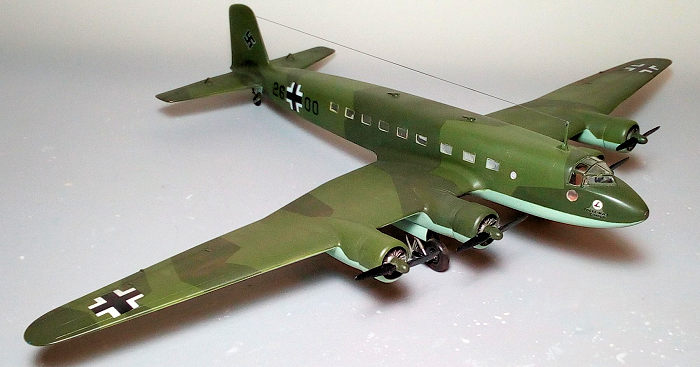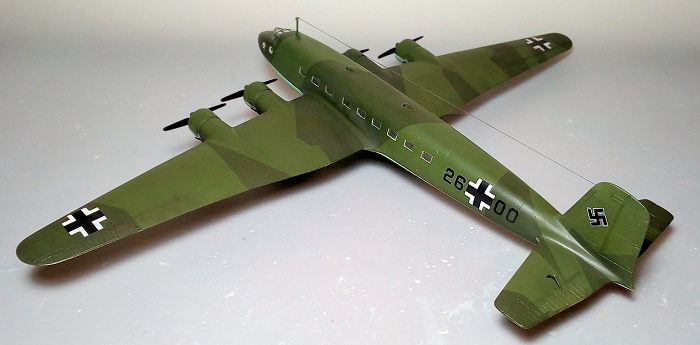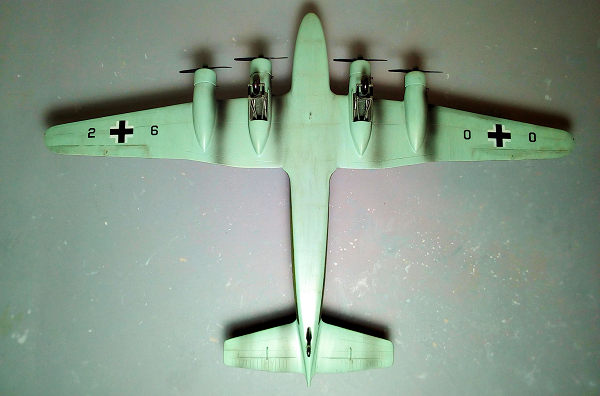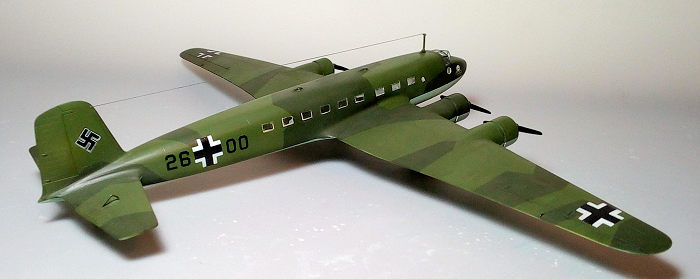
| KIT #: | 4387 |
| PRICE: | €10 in 2005 |
| DECALS: | Two options |
| REVIEWER: | Spiros Pendedekas |
| NOTES: | Finished as Hitler’s personal transport |

| HISTORY |
Designed by Kurt Tank,
the Fw 200 resulted from an interwar Deutsche Lufthansa specification for a
transatlantic passenger landplane, an aggressive and unusual concept at the time
where airlines used seaplanes on long over-water routes. Whereas existing
airliners cruised at altitudes below 5,000 ft, the Fw 200 was designed to cruise
economically at an altitude of over 9,800 ft – the highest
 possible
without a pressurized cabin. Until the arrival of Boeing 307 Douglas DC-4 in
early 40s, the Fw 200 was the world's most modern airliner. The designation
"Condor" was chosen because of its very long wingspan, like the condor bird.
possible
without a pressurized cabin. Until the arrival of Boeing 307 Douglas DC-4 in
early 40s, the Fw 200 was the world's most modern airliner. The designation
"Condor" was chosen because of its very long wingspan, like the condor bird.
Upon Japanese Navy’s interest for a “Search and Patrol '' military version, the 10th prototype was designed with military equipment. Ultimately, the specific aircraft was held in Germany as war broke out, becoming the basis for all later military Condors used by the Luftwaffe.
In order to replace his somewhat limited capability Ju-52, at the suggestion of his personal pilot Hans Baur, Adolf Hitler chose the third Fw 200 prototype (the V3, Werknummer 3099), as his personal transport. The specific machine was reconfigured as a plush two-cabin airliner, with Hitler's seat equipped with a wooden table, a seat-back armor plating and an automatic downward firing parachute. It was originally painted per the Lufthansa livery. In line with Hitler's preferences, it carried the markings "D-2600" and was named "Immelmann III" in honor of Max Immelmann. As the war progressed it changed designation to "WL+2600" and finally, to "26+00", painted per the standard Luftwaffe camo. It was destroyed at Berlin Tempelhof Airport in an Allied bombing raid on 18 July 1944.
| THE KIT |
First appearing in 1990 and reboxed twice till 1992 with only different schemes offered, this was one of the then “new generation” Revell kits, featuring interesting subjects, modern tooling and not over-complicated engineering, “build at a price”, if one is allowed to say. A hunter for old stock kits, yours truly was lucky enough in 2005 to discover a forgotten copy of the first (1990) edition of this kit, still sealed, at a killer price of €10. Needless to say, I grabbed it immediately.
 The
specific kit came at a flimsy top opening box (I was expecting a side-opener),
depicting a Lufthansa Fw 200 proudly flying. Upon opening the box, I was greeted
with four sprues of flash-free molded white styrene: one sprue containing the
fuselage halves, two sprues containing the wing halves, with a final larger
containing all the rest. Detailing was superbly engraved all over, but some
warpage was noticed at the wing halves.
The
specific kit came at a flimsy top opening box (I was expecting a side-opener),
depicting a Lufthansa Fw 200 proudly flying. Upon opening the box, I was greeted
with four sprues of flash-free molded white styrene: one sprue containing the
fuselage halves, two sprues containing the wing halves, with a final larger
containing all the rest. Detailing was superbly engraved all over, but some
warpage was noticed at the wing halves.
Cockpit is adequately represented with seats, control columns, an instrument panel, onto which a decal is to be affixed and a central console with fine raised dials. No passenger interior is provided whatsoever, not even a floor, with the emptiness being noticeable among close inspection through the relatively large side-windows. The intricate landing gear is very well represented, with raised details molded onto the top bay walls. The engines are provided as “faces”, but have sufficient depth and are very well detailed. The two bladed props look good.
Transparencies are nicely molded and crystal clear. Instructions are typical Revell, very sufficient, with the construction spread in 19 clear steps. Two nice schemes are catered for, a Lufthansa and a gorgeous Danish Luftfartselskab bird. The big decal sheet was well printed, but looked cautiously matt, let alone the fact that it was very old.
| CONSTRUCTION |
 I started by
attaching all 21 side windows from the inside of the fuselage halves, which were
then joined, with the 6-piece already assembled cockpit trapped between them. My
job on the side windows was less than perfect, with amounts of liquid glue
smeared onto some windows innards, including the small round starboard one,
where the smearing was so bad that I had to paint its inner side chrome, in
order to look less offending! Basic cockpit and cabin color was RLM02 (Hu31),
with black instrument panel, central console and control yokes and leather seat
cushions. I applied the instrument decal and dry brushed the central console
with silver, adding some red "dials" with a 10/0 brush. Seat belts made from
masking tape were added as well.
I started by
attaching all 21 side windows from the inside of the fuselage halves, which were
then joined, with the 6-piece already assembled cockpit trapped between them. My
job on the side windows was less than perfect, with amounts of liquid glue
smeared onto some windows innards, including the small round starboard one,
where the smearing was so bad that I had to paint its inner side chrome, in
order to look less offending! Basic cockpit and cabin color was RLM02 (Hu31),
with black instrument panel, central console and control yokes and leather seat
cushions. I applied the instrument decal and dry brushed the central console
with silver, adding some red "dials" with a 10/0 brush. Seat belts made from
masking tape were added as well.
I attached the main landing gear bays from the inside of the lower wing halves and then attached the top halves. With the glue still uncured, in order to deal with the above mentioned warping, I brutally straightened by hand the already assembled wings and then clamped them. To my relief, upon glue curing, no sign of warpage or misalignment was evident.
I then proceeded and attached the wings to the fuselage, followed by the horizontal stabilizers (4-piece each, including their hinge mechanisms). Fit was good and alignment was easy. After some filling and sanding here and there (not that much, really). I masked the installed transparencies, temporarily affixed the engine cowlings, blanked the cockpit opening with masking tape and headed to the paint shop!
| COLORS & MARKINGS |
 I decided
to depict Hitler’s “26+00” machine, sporting its latest wartime splinter camo,
which was easily found by netting. I started by applying Hu65 Light Blue at all
undersides, including doors, then masked them off. I then applied at all
topsides Hu117 for the RLM71, masked it off per the net found pattern and
continued with the RLM70, for which I used Hu116, with the props receiving the
same color, as well.
I decided
to depict Hitler’s “26+00” machine, sporting its latest wartime splinter camo,
which was easily found by netting. I started by applying Hu65 Light Blue at all
undersides, including doors, then masked them off. I then applied at all
topsides Hu117 for the RLM71, masked it off per the net found pattern and
continued with the RLM70, for which I used Hu116, with the props receiving the
same color, as well.
Upon removing the masks, I gave the model a coat of Future and went on applying the decals. I used leftover decals (including numbers) of suitable sizes, in order to closely match the reference scheme. I attached the Focke Wulf logos at the front, using the kit provided decals: they did silver a lot, though… A coat of Future sealed all decals.
| FINAL CONSTRUCTION |
I assembled the very nice pair of 5-piece main gear legs (a very prominent feature of the Condor) and installed them at the bays, followed by the gear doors. The two piece equally nice main wheels were then attached, followed by the one piece rear wheel/leg (which needed some tweaking in order to fit - it was supposed to have been attached before joining the fuselage halves). Main landing gear color (including bays and door innards) was RLM02, with black protective gaiters and silver oleos (the latter done with a fine tip silver pen). A silver dry brushing accentuated all raised details inside bays and at door innards. Wheels had black rims, also dry brushed with silver. Tires were painted black, as I assumed the Luftwaffe would use “real” rubber for the tires of this “V.I.P.” plane!
 The engine
faces were attached in the cowlings, followed by the props. The whole
subassemblies were then permanently attached to the wings. Engines were painted
black and dry brushed with silver; cowling innards were black, as well. The four
exhausts were painted Testors burned metal and attached. The antenna mast and
the front “Frischluft” air inlet mesh (painted gunmetal) were attached at this
time, as well. Finally, what looks like an additional underside antenna mast was
attached at the belly.
The engine
faces were attached in the cowlings, followed by the props. The whole
subassemblies were then permanently attached to the wings. Engines were painted
black and dry brushed with silver; cowling innards were black, as well. The four
exhausts were painted Testors burned metal and attached. The antenna mast and
the front “Frischluft” air inlet mesh (painted gunmetal) were attached at this
time, as well. Finally, what looks like an additional underside antenna mast was
attached at the belly.
I then went on to apply some engine staining by subtly airbrushing black paint aft of the exhausts, to the direction of the airflow . The net result looked somehow emphasized, but I decided not to lessen it, as it gave a dramatic look to the otherwise plain undersides.
Rest of the weathering included a black wash (more heavily applied inside the bays) and general dirtying (mostly undersides). A final matt (towards satin) coat sealed everything and gave this bird its final finish.
After having its well-defined frames painted by hand, the canopy was attached in position. The wingtip lights were represented by mini blobs of red and green clear paint. For the antenna wire, stretched sprue was run from the front mast to the fin, before calling this VIP transport done!
| CONCLUSIONS |
It was a very enjoyable build of this iconic airliner. Construction was easy, (the kit being not over engineered at all) and fit was good. Basic shape looks accurate, cockpit and landing gear are well appointed, with the less-than-perfect transparencies job positively being yours truly fault!
The total lack of any passenger cabin will most probably cast a gloom over the majority of modelers, who would at least wish some generic detail in there (a floor and some seats/tables, for example). In fact, this omission seems weird, not on par with the rest of the kit detailing, as if the kit designer forgot to add it! No dedicated aftermarket interior seems to exist, meaning the wishful modeler will be on his own (with the addition of “curtains” from the inside sounding not too bad of an idea, by the way...).
After its initial three versions released, between 1990 and 1992, the kit has never been re-released. This might have meant low sales numbers (for which the absence of passenger interior might have possibly contributed). Since this is a very interesting modeling subject, I believe the idea of reissuing it has definitely come across Revell. Speculating, it would not surprise me if I see a future release of this kit with a new “extra sprue”, catering for the passenger interior.
This kit is extremely hard to find nowadays with astronomical prices asked for any scarce found. If you happen to own one, you might consider giving it a go, maybe scratch build some interior too!. Those birds carried few in variety but very attractive schemes (apart from the Lufthansa/Luftwaffe, how about a beautiful Danish, Brazilian or BOAC version?).
Happy modeling!
| REFERENCES |
Germanaircraftwwii.org
5 April 2022
Copyright ModelingMadness.com. All rights reserved. No reproduction in part or in whole without express permission.
If you would like your product reviewed fairly and fairly quickly, please contact the editor or see other details in the Note to Contributors.